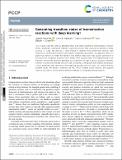| dc.contributor.author | Pattanaik, Lagnajit | |
| dc.contributor.author | Ingraham, John | |
| dc.contributor.author | Grambow, Colin A. | |
| dc.contributor.author | Green Jr, William H | |
| dc.date.accessioned | 2020-11-19T18:41:55Z | |
| dc.date.available | 2020-11-19T18:41:55Z | |
| dc.date.issued | 2020-10 | |
| dc.date.submitted | 2020-09 | |
| dc.identifier.issn | 1463-9076 | |
| dc.identifier.issn | 1463-9084 | |
| dc.identifier.uri | https://hdl.handle.net/1721.1/128542 | |
| dc.description.abstract | Lack of quality data and difficulty generating these data hinder quantitative understanding of reaction kinetics. Specifically, conventional methods to generate transition state structures are deficient in speed, accuracy, or scope. We describe a novel method to generate three-dimensional transition state structures for isomerization reactions using reactant and product geometries. Our approach relies on a graph neural network to predict the transition state distance matrix and a least squares optimization to reconstruct the coordinates based on which entries of the distance matrix the model perceives to be important. We feed the structures generated by our algorithm through a rigorous quantum mechanics workflow to ensure the predicted transition state corresponds to the ground truth reactant and product. In both generating viable geometries and predicting accurate transition states, our method achieves excellent results. We envision workflows like this, which combine neural networks and quantum chemistry calculations, will become the preferred methods for computing chemical reactions. | en_US |
| dc.language.iso | en | |
| dc.publisher | Royal Society of Chemistry (RSC) | en_US |
| dc.relation.isversionof | http://dx.doi.org/10.1039/d0cp04670a | en_US |
| dc.rights | Creative Commons Attribution 3.0 unported license | en_US |
| dc.rights.uri | https://creativecommons.org/licenses/by/3.0/ | en_US |
| dc.source | Royal Society of Chemistry (RSC) | en_US |
| dc.title | Generating transition states of isomerization reactions with deep learning | en_US |
| dc.type | Article | en_US |
| dc.identifier.citation | Pattanaik, Lagnajit et al. "Generating transition states of isomerization reactions with deep learning." Physical Chemistry Chemical Physics 22, 41 (October 2020): 23618-23626 © 2020 Owner Societies | en_US |
| dc.contributor.department | Massachusetts Institute of Technology. Department of Chemical Engineering | en_US |
| dc.contributor.department | Massachusetts Institute of Technology. Computer Science and Artificial Intelligence Laboratory | en_US |
| dc.relation.journal | Physical Chemistry Chemical Physics | en_US |
| dc.eprint.version | Final published version | en_US |
| dc.type.uri | http://purl.org/eprint/type/JournalArticle | en_US |
| eprint.status | http://purl.org/eprint/status/PeerReviewed | en_US |
| dc.date.updated | 2020-11-16T16:46:33Z | |
| dspace.orderedauthors | Pattanaik, L; Ingraham, JB; Grambow, CA; Green, WH | en_US |
| dspace.date.submission | 2020-11-16T16:46:37Z | |
| mit.journal.volume | 22 | en_US |
| mit.journal.issue | 41 | en_US |
| mit.license | PUBLISHER_CC | |
| mit.metadata.status | Complete | |
